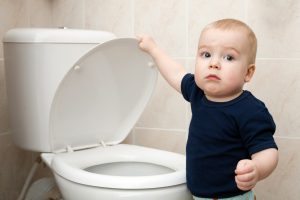
Constipation in children can be a very common and unpleasant condition. It can be quite distressing for families to deal with. There are many causes of constipation in children, and treatment can vary greatly depending on the cause. There are multiple avenues of treatment for this condition, and even if one treatment approach has failed, there are still likely to be other options to trial.
To maintain bowel continence, children need to have:
- Ability to detect a stool in the rectum
- Good movement speed throughout the bowel (peristalsis)
- Sphincter control (circular muscle surrounding anal opening that opens/closes)
- Ability to contract and relax pelvic floor muscles
What should occur?
In normal defecation, the stool moves into the rectum causing slight distension (widening) through the rectum which triggers a relaxation response of the internal anal sphincter. The stool then moves to the lower rectum and is stored between the internal anal sphincter and the external anal sphincter. The stool should only stay in this area for 0-2 hours ideally before being passed. If it is not a convenient or socially acceptable time to pass a bowel motion, there is an option for deferral. In this case, the external anal sphincter and pelvic floor muscles will contract to prevent expulsion of the stool, thus maintaining continence. When convenient, the bowel motion can later be passed by relaxing the external anal sphincter and pelvic floor muscles.
What can cause problems?
Poor ability to relax the external anal sphincter and pelvic floor muscles can lead to straining when passing a bowel motion which can sometimes cause pain. Children who experience pain when passing a bowel motion may then develop a fear associated with future bowel motions and delay passing a stool to avoid further pain. Overtime, this can lead to a back-up of stool in the child’s rectum which can lead to increased distension in this area. Long term rectum distension can lead to difficulty for children to detect when it’s time to pass a bowel motion as they no longer get the sensation of a full rectum. If children do not contract their external anal sphincter or pelvic floor muscles when a stool passes into the lower rectum, faecal incontinence can occur.
If back-up in the rectum is long-term or if children constantly defer passing a bowel motion, the bowel sends a message to the brain to slow down the speed in which food is digested which can cause increased absorption of water. This can then lead to development of harder stools. These harder stools can be more painful to pass, and again contribute to the cycle of stool deferral due to pain.
Children with disabilities also experience constipation, often at a higher rate. The cause of constipation is often the same as described above, however also may include generalised decreased peristalsis (slow digestion), weakness through the abdominal muscles and asymmetrical muscle strength from the left to right due to their diagnosis. Medications that these children may be taking for other reasons can also play a role in reducing intestinal motility.
Treatment options:
Physiotherapy treatment options for constipation can include toilet positioning education and modification, abdominal and pelvic floor exercises, kinesiology taping, abdominal massage, and establishment of a bowel routine. Children with constipation are usually best treated with a combination of medical management and physiotherapy.
Emily Evans at our City West Clinic has completed further training in the treatment of paediatric conditions.

